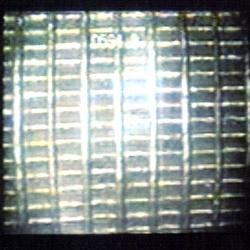![]() P.O. Box 2039 Lubbock, TX 79408
P.O. Box 2039 Lubbock, TX 79408 ![]() (800) 457-2096
(800) 457-2096
Well Rehabilitation
Why Well Rehabilitation Makes Good Sense
By Matt McGinnis—Engineer, Cotey Chemical Corp.


Before (left) and after (right) pictures of a well screen on a well that has been rehabilitated.
Rehabilitate: to restore, reinstate, to put back in good condition, to re-establish. However you choose to define “rehabilitate”, when it comes to water wells, we all know what we’re really after: get this thing making water (money) again in the cheapest way possible. What if someone stated that they could not only get your well working again, but also save money in energy costs, restore lost capacity, increase the life of the pump, improve water quality and extend the overall life of the well just by doing quality well rehabilitation? Would you be interested? Eddie, a farmer in West Texas, was interested. I’d like to use his story as a basis for answering some water well rehabilitation questions from a business perspective.
Eddie has a water well in Crosby County that produced for a ¼-mile pivot (120 acres). He suspected the old well was beginning to plug, so he called his contractor to discuss his suspicion. His contractor suggested rehabilitating the well with a technique utilizing both mechanical and chemical methods. Eddie agreed and the rehabilitation was successful. Unplugging his well restored its lost capacity and increased the pumping water level by 50 feet. This change in drawdown saved him $1,036.80 last year in electricity costs alone because the pump didn’t have to lift the water as far as it had the year before. As a bonus the quality of his water improved significantly.
The first question to be answered was how Eddie knew to suspect his well was beginning to plug. The answer is two-fold. First, research tells us that all water wells begin plugging, albeit in tiny amounts, from the day they first began to produce. Whether by hard water deposits, biofouling or both, all water wells develop plugging problems over time. Second, a well owner should know or be able to find, information on the history of the well; specifically, what was the original flow and the original drawdown. The relationship between these two is called Specific Capacity. Specific Capacity, then, is water flow from the well measured in gallons per minute divided by the pumping water level drawdown measured in feet. Once the well owner discovers specific capacity history for the well he should make a habit of checking the specific capacity every year at the same time and comparing it to previous years. And he should keep an eye on energy costs. If there is fluctuation in either of these parameters, suspect well plugging.
However, keep in mind that monitoring specific capacity and energy costs alone to determine well plugging does not necessarily tell the whole story. Some theorize that there exists a direct percentage link between specific capacity drops and well plugging. For example, a specific capacity drop of 20% in a well should indicate that the well is about 20% plugged. This theory is not always accurate. Documented cases have shown wells with specific capacity drops of relatively small amounts that end up, upon video-inspection, being almost totally plugged. So, what are we left to believe? We will discuss this in more detail in the next month’s edition of WWJ.
Another question to examine is why Eddie’s contractor suggested both mechanical and chemical methods to clean his well. In broad terms there are two major categories into which most rehab solutions are placed: mechanical and chemical. Again, in broad terms, mechanical solutions are initiated in the well bore and intended to resound through the screen, gravel pack (when used) and into the water-bearing formation to unstop water pathways. While these solutions have a place and work effectively in some contexts their main constraints are the well itself. Mechanical energy, like chemical energy, must have direct contact with the well-plugging masses to work properly. Unfortunately, the well screen, gravel pack and even the formation all act to deflect mechanical energy from its intended targets.
Chemicals, however, because they travel with and similar to water, are capable of penetrating and dissolving plugging materials both in and around the well bore and far out into the water-bearing formation. For this reason, using the proper chemistry to unstop water well plugging problems provides a thoroughness that mechanical energy alone is incapable of.
The real well-plugging problems are not the soft biomasses, which are easily removed using either mechanical or chemical means. The bigger issues are always the extremely hard, cement-type deposits that plug water pathways on the well screen, in and around the gravel pack and all through the formation. Again, appropriate chemical solutions have advantages over purely mechanical means. Most mineral plugging is outside the well screen. Mechanical energy can’t penetrate deeply enough to impact those deposits. Moreover even when mechanical solutions succeed in breaking up the hard minerals inside the well screen they fall short in creating small enough pieces to be removed from the well. Chemicals, on the other hand, can completely break down these deposits and hold them in suspension to be easily removed from the well. Also, they are able to impact mineral deposits far beyond the initial mechanical barriers. However, chemicals only affect that which they are able to contact. Recognizing this limitation, the best results for solving water well plugging problems are found by utilizing some combination of both mechanical and chemical methods.
Eddie, from the example above, is just one of many success stories in the culture of well rehab. Contractors are using techniques that utilize both mechanical and chemical methods to rehabilitate water wells. The alternatives are to drill new wells or do nothing and hope for the best. But, by rehabbing those wells they save money, restore lost capacity, increase the life of the pump, improve water quality and extend the overall life of the well for owners all over the country.
